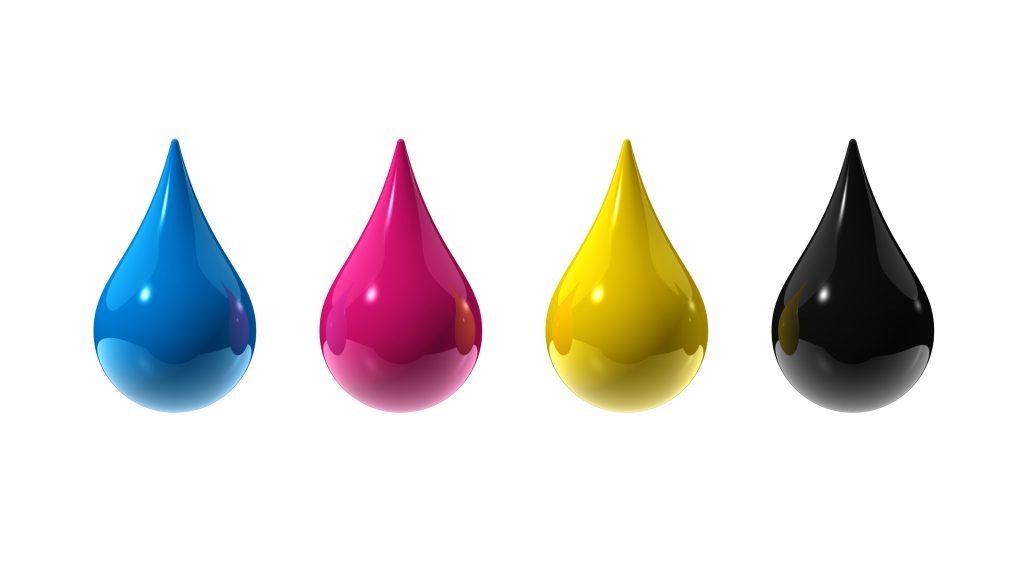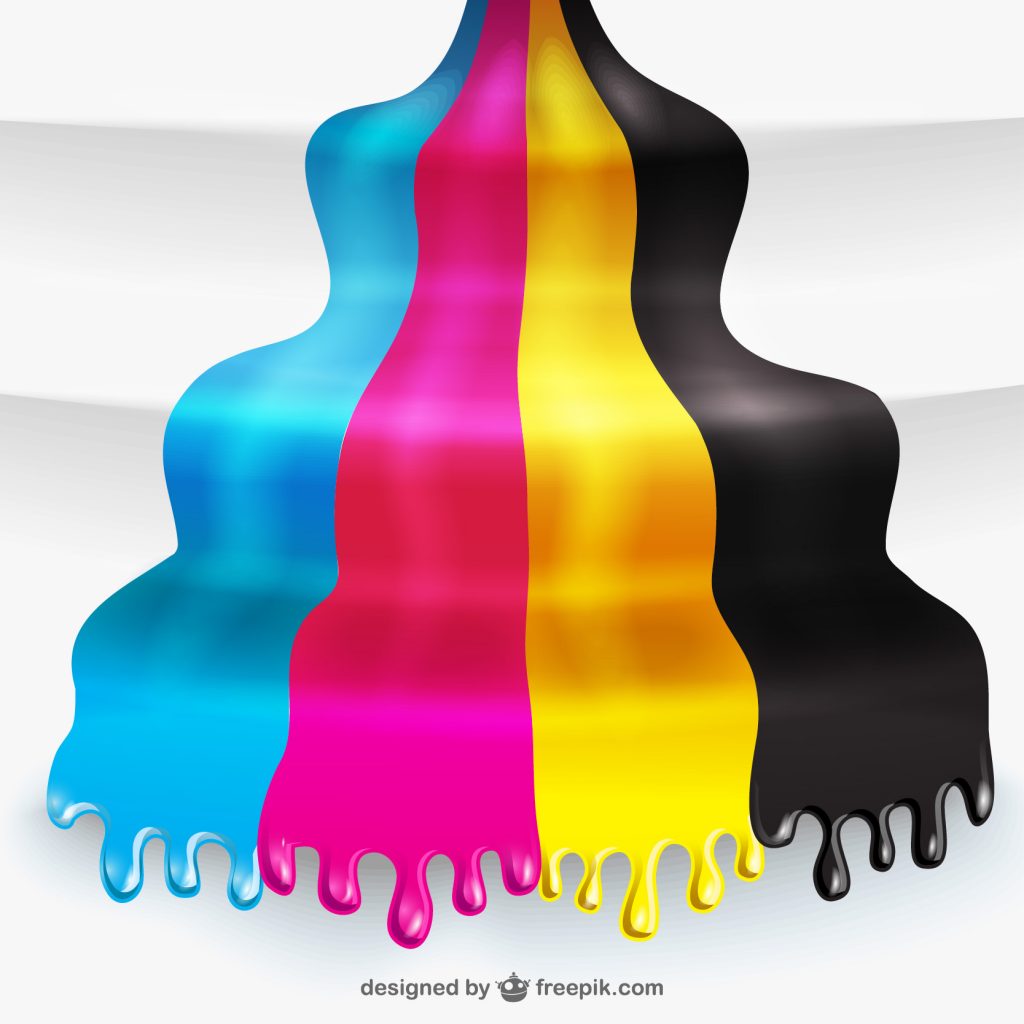
The structure and composition of the ink require many considerations, such as fillers, thinners, anti-skinning agents, anti-offset agents, slip agents, and other additives. As far as the filler is concerned: it is an auxiliary agent that adjusts the ink concentration, it can also increase the thickness of the ink film layer and improve its wear resistance. It has no tinting power and hiding power. Mainly include barium sulfate, talc powder, calcium carbonate, aluminum hydroxide, etc., which are crushed into white powder when used.
Ink composition:
1.Pigments, solid components in inks, colored, black or white high-dispersion powder substances that are insoluble in water and organic solvents, are the color-developing substances of inks, and it can be divided into two categories: organic pigments and inorganic pigments. The saturation, tinting strength, transparency and other properties of the ink color are closely related to the properties of the pigment.
2.The connecting material, the liquid component of the ink, and the connecting material can be made of various materials, such as dry vegetable oil, mineral oil, solvent and water, and various synthetic resins. The fluidity, viscosity, neutral acid value, color density, water resistance and printed matter performance of the ink during usage processing are all depended on the binder.
3.Filler, a white transparent, translucent or opaque powdery substance, plays the role of filling. Appropriate use of some fillers in the pigment can not only reduce the amount of pigment to reduce costs, but also adjust the thinness and fluidity of the ink, and also improve the flexibility of the ink formulation design.
Additional materials, some materials added in order to improve the performance of the ink itself in ink manufacturing or printing usage process. When the ink composed of the basic formula still can not meet the requirements of use in some aspects, or can not meet the requirements of printing usage process due to changes in conditions, a small amount of additional materials must be added to solve the problem.
Water-based ink and flexible graphic water-based ink is also called liquid ink. It is mainly made of water-soluble resin, organic pigments, solvents and related additives through compound grinding. Water-based inks are especially suitable for packaging and printing products that require strict sanitary conditions such as tobacco, alcohol, food, beverages, medicines, and children’s toys.
1.The basic formula of water-based ink:
Water-soluble acrylic resin 25% ~ 35%;
Water 15% ~ 25%;
Ethanol 5% ~ 15%;
Triethylamine 5% ~ 10%;
Pigment 10% ~ 30%;
Additives 1% ~ 3%.
2.Water-based ink components: water-based inks are composed of water-based polymer emulsions, pigments, surfactants, water and other additives.
(1) Water-based polymer emulsion
It is mainly acrylic and ethyl styrene compounds. The role is to transfer the pigment carrier, providing adhesion, hardness, brightness, drying speed, abrasion resistance, water resistance. Film-forming emulsions are used for printing on the surface of non-absorbent substrates; non-film-forming emulsions are used for printing on absorbent materials such as paper and cardboard.
(2) Pigment
Organic pigments include phthalocyanine blue and Lithol red; inorganic pigments include carbon black and titanium dioxide.
(3) Surfactant
The function of surfactant is to reduce the surface tension, make the ink spread on the substrate, and improve the stability of the ink.
The ink should have certain fluidity and meet the properties required by various printing processes, and be able to dry quickly on the printed product. The dried ink film should have corresponding various water resistance, acid resistance, alkali resistance, light resistance, rub resistance, resistance to abrasion, etc. The liquid component in the ink component is called the binder; the solid component is the colorant (pigment or dye) and various additives.
For inks, color, body bone (the rheological properties of ink such as thinness, fluidity, etc are usually called ink body bone) and drying performance are the three most important properties of ink, which are also the development of ink formulation, technology and production, attention should be paid; the printing film on the printed product should have a certain resistance to make the printed product have practical use. Mastering the deployment of spot color inks, controlling the amount of inks, and making full use of the remaining ink will not only save materials, but also improve personal quality and technical level.
The physical and chemical properties of ink mainly refer to its density, fineness, transparency, gloss, light resistance, heat resistance, and acid, alkali, water, and solvent (alcohol) resistance.
In terms of density: Density refers to the weight of ink per unit volume at 20°C. Expressed in g/cm. The density of the ink is determined by the type and ratio of the raw materials used in the ink, and is affected by the external temperature. The density of the ink has a certain relationship with the printing process. The density of the ink is related to the amount of ink used in the printing process. Under the same printing conditions, the amount of ink with higher density is greater than that of ink with lower density.
The density of the ink is too high, mainly due to the high density of the pigment in the ink. In the printing process, because the binder can not drive the pigment particles with too high density to transfer together, the solid particles such as the pigment are accumulated on the surface of the ink roller, printing plate, or blanket, forming a blockage phenomenon. Especially in high-speed printing or ink thinning, the use of high-density ink is more prone to this phenomenon. At the same time, when the high-density ink is mixed with the low-density ink, if the difference between the two is too large, the ink color delamination is likely to occur. The ink with low density floats up and the ink with high density sinks, so that the color of the ink surface is biased toward the ink with a lower density, and the color of the bottom ink is biased toward the ink with a higher density.
Generally, the density of printing ink is between 1g/cm and 2.25g/cm.
- The blending of inks is based on the principle that the three primary colors of Y, M, and C can be mixed into black in a certain proportion.
- The three primary color inks Y, M, C can be mixed in equal proportions to mix black, and add different proportions of diluent to get different degrees of neutral gray.
- Three primary color inks Y, M, and C can be mixed in different proportions to obtain different colors or multiple colors. The primary colors of Y, M, and C three primary colors are R, G, B, and Y, M, and C are multiple colors. One thing to note is that the mixed hue is biased to the hue of the ink with a large proportion.
- The two primary colors of ink are mixed in equal amounts to obtain the standard intermediate color.
| M | T | W | T | F | S | S |
|---|---|---|---|---|---|---|
| 1 | 2 | 3 | 4 | 5 | 6 | |
| 7 | 8 | 9 | 10 | 11 | 12 | 13 |
| 14 | 15 | 16 | 17 | 18 | 19 | 20 |
| 21 | 22 | 23 | 24 | 25 | 26 | 27 |
| 28 | 29 | 30 | ||||
Recent Posts
- Ultimate Guide to UV Printing: Insider Tips and Tricks
- Before You Invest: Choosing a Large Format Flatbed Printer
- Maximizing Brilliance: Mastering UV Printer Settings for Optimal Media Reflectivity
- The advantages of using a WER UV printer for large format printing (2)
- Achieve Stunning Results in Home Décor and Architectural Design with UV Printer
Archives
- January 2025
- November 2024
- September 2024
- March 2024
- December 2023
- November 2023
- October 2023
- May 2023
- March 2023
- February 2023
- January 2023
- December 2022
- November 2022
- October 2022
- September 2022
- February 2022
- January 2022
- December 2021
- November 2021
- October 2021
- September 2021
- August 2021
- July 2021
- June 2021
- May 2021
- April 2021
- March 2021
- February 2021
- January 2021
- December 2020
- November 2020
- October 2020
- September 2020
- August 2020
- July 2020
- June 2020
- May 2020
- April 2020
- March 2020
- February 2020
- January 2020
- December 2019
- November 2019
- October 2019
- September 2019
- August 2019
- July 2019
- June 2019
- May 2019
- April 2019
- March 2019
- February 2019
- January 2019
- December 2018
- November 2018
- October 2018
- September 2018
- August 2018
- July 2018
- June 2018
- May 2018
- April 2018
- March 2018
- February 2018
- January 2018
- December 2017
- July 2016
- June 2016
Recent Posts
- Ultimate Guide to UV Printing: Insider Tips and Tricks
- Before You Invest: Choosing a Large Format Flatbed Printer
- Maximizing Brilliance: Mastering UV Printer Settings for Optimal Media Reflectivity
- The advantages of using a WER UV printer for large format printing (2)
- Achieve Stunning Results in Home Décor and Architectural Design with UV Printer
